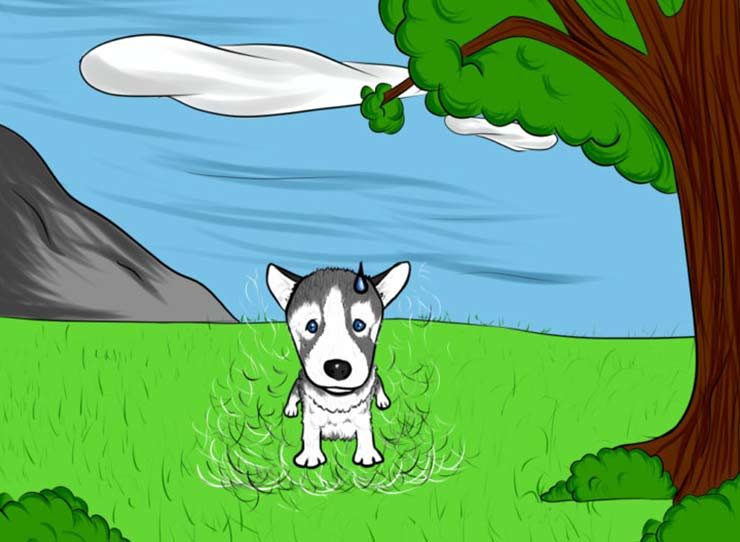
There’s no doubt that the adorable face of a Pomsky will draw you in. Plus, who can resist their beautiful coat? Questioning if a dog sheds or not may not be the top question on your list. But, before you get a dog, or even after, it may be a question that pops into your mind. What about the beautiful Pomsky? Does the Pomsky shed?
Like with any dog mixed with two breeds, you have to look at the parents. What kind of coat do the parents have? What kind of coat does that breed have? This will tell you a lot about what kind of coat your Pomsky will have.
Since the Pomsky is a mix of Siberian Husky and Pomeranian, we have to look at those breeds coats. One thing is for sure, these are breeds that need some grooming. While their coats are gorgeous, their coats need a little time put into them. The time that’s invested into their coat care is what keeps their coats beautiful.
The Siberian Husky Coat
The Siberian Husky is a double coated dog. “Double coated” just means that there is a top coat that has tough hairs and an under coat that is soft, but thick. Siberian Huskies aren’t known to be “stinky” dogs. But, they do through intense shedding at least twice a year.
The twice yearly shedding Siberian Huskies take part in is “blowing their undercoat.” When a Siberian Husky blows their undercoat, they completely shed their undercoat. So, as you can imagine, this can get messy. Although it only happens twice a year, blowing their undercoat may last up to three weeks each time.
But, in warmer areas, it’s often noted that Siberian Huskies shed all year round. So, the shedding may depend on where you live. You may get lucky with the blowing of the undercoat only twice a year. You could end up picking up little wads of hair year round.
The Siberian Husky does have cat like qualities. This doesn’t mean they’ll play with a ball of yarn. Although that would be cute. They have cat like qualities when it comes to cleanliness. It’s almost as if they clean their fur like a cat. They do “bathe” themselves on a regular. That’s why they’re not considered “stinky dogs.”
But, you could meet a Siberian Husky that is more interested in play than grooming themselves. These may need more time spent on their grooming than a “cat like” Siberian Husky. If their coat becomes too dirty, and it isn’t kept clean, some serious matting could occur.
Matting is when the fur becomes tangled together. The fur may become so tangled it becomes attached to the skin. This isn’t just difficult to remove. It can be dangerous and painful. You can reduce matting by making sure the coat stays clean and that you brush the coat on a regular basis.
The Pomeranian Coat
The Pomeranian, like the Siberian Husky, is also a double coated dog. A double coated dog that also may experience two major sheds during the year. Although there is some shedding through out the year.
Just like the Siberian Husky, the Pomeranian also may shed more in a warmer climate. There is a chance if you’re a cooler climate, you may meet a Pomeranian that doesn’t seem to shed as much. But, regardless, the Pomeranian still loses a little hair year round.
Pomeranian’s do need regular grooming. Their fur may also become matted. Which, once again, can be painful. Severe matting may also cause infection. Pomeranian’s may also need a trim once in a while as well. Regular brushing is important when it comes to taking care of a Pomeranian’s coat.
The Pomeranian and Siberian Husky “Baby Coat”
The examples above are what you might experience with an adult dog. But, before the get their “adult coat,” they’ll have a “baby coat.” So, there shouldn’t be any alarm if a cute puppies coat begins to change. They’re just turning into an “adult.” It’s part of life.
The Pomeranian “Baby Coat”
When a Pomeranian is born, they only have one coat. This coat is pretty soft. Also, the coat of a baby Pomeranian is smooth as well. But, after about 4 months, that soft fur may begin to disappear. The fur may begin to fall out at a pretty fast rate.
The hair falling out is just making way for that beautiful, thick coat that is coming. You’ll being to see that thick fur coat come in. Some Pomeranian’s may not have their full “adult coat” until their about 15 months old.
The Siberian Husky “Baby Coat”
Just like the Pomeranian, when a Siberian Husky is a baby you will also get to experience that soft coat of fur. Around 4 months old, though, you’ll also experience the same hair loss. That soft fur you once enjoyed may now be a distant memory. A distant memory that appears as clumps of fur on your living room floor.
When the puppy reaches that 4 month (or 5 month) mark, they’ll have their first “coat blowing.” Some Siberian Huskies may look “awkward” during this stage. But, don’t worry, this is just a phase. It will pass. Then you can experience all the joys of their “adult coat.”
Pomsky Shedding
The Pomsky is a newer breed on the “designer dog” scene. But, we do know a little about their shedding habits. They do shed quite a bit. They do need regular grooming. When considering a Pomsky, you should make sure you’re aware of the grooming costs.
Just like their parents, Pomskies also blow their under coat twice a year. This may lead to double (or even triple) the amount of daily shedding you see. It’s important to keep their coats free of debris and clean. It’s also important to brush them on a regular basis.






